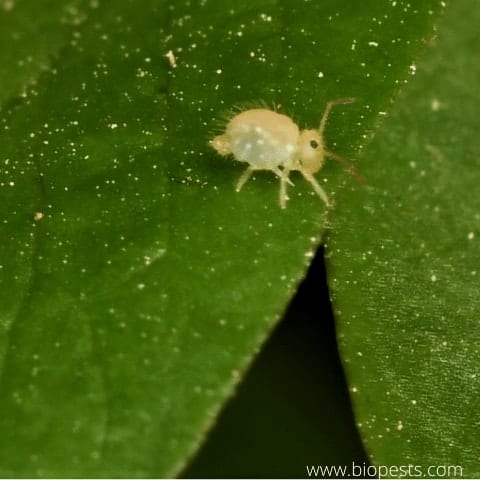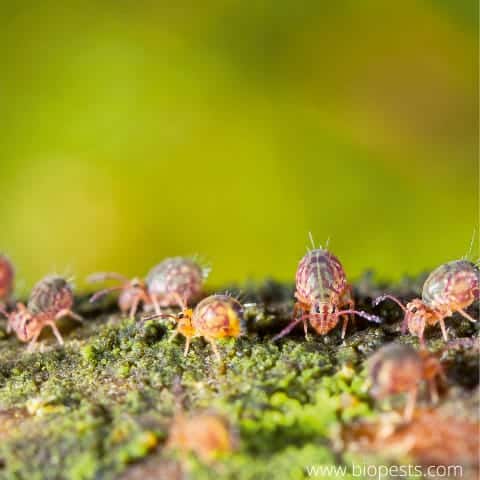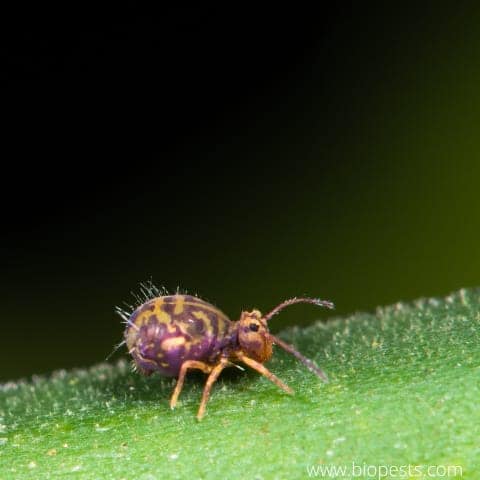Have you ever got the fright of your life when, while watering your houseplants, a small, possibly greyish, whiteish bug springs up into the air and then drops right back down? The bug introducing itself to you is, in fact, a tiny jumping arthropod, more commonly known as a springtail. When it feels threatened, it jumps up into the air, hence its name!
You can effectively get rid of springtails in houseplants by following these six simple steps.
- Allow the soil to dry out
- Use soil with less peat
- Wipe them away
- Vacuum the eggs
- Spray with eradicating solutions
- Dust with diatomaceous earth

The springtail has been reclassified and is no longer known as an insect – it is now part of the collembola family, which lies somewhere between a crustacean and an insect. Either way, no matter what it is called, a springtail can actually be beneficial to your houseplants, and in fact, to all plants in general.
Are Springtails Good For Houseplants?
A springtail is one of the most common bugs globally, with more than 8000 different recorded species. A very tiny creature, the springtail is barely visible to the naked eye, around 1/8 of an inch (3mm) long. It is almost blind and wingless and is found in soil everywhere, all around the world. Snow fleas are a type of springtail found in the snow!
The springtail is considered to be a beneficial creature so if you do have them living in your houseplants, let them stay! Certain species will occasionally nibble on the root tips of some plants, but this is good for your plants as it stimulates better rooting by spreading beneficial fungi to the plant’s roots.
Springtails live in leaf litter, compost piles, and lawn soils. They are detritivores and fungivores, which means they consume waste garden products like algae, fungi, and decomposing organic matter, recycling the dead plant material into nutrients to fertilize your plants.
The presence of springtails in your houseplants generally indicates good soil and healthy plants as the springtail needs moisture as they breathe through their skin. If the soil is dry, the springtails can die.
Are Springtails Dangerous?
Springtails do not bite, sting, transmit diseases, or damage clothing, food, household furniture, or structures. In addition, they cannot damage your plant permanently as your plant will bounce back to its original conditions once the springtail has moved on.
An infestation could be beneficial to your houseplants but may become unsightly if their numbers increase too much. If you are happy for the springtails to mulch the soil to provide extra nutrients to your plants, then leave them alone. If they do overrun your houseplants and become too many, then you may have to remove them.
Springtails favor damp conditions and organic debris and are most active in the afternoon or early evening when they will be on the move looking for a new home. They also feed on dead flies, worms, and dangerous fungi found in your houseplants, which aids the ecosystem.
Springtails are not considered harmful creatures but are often known as pests because of their presence which detracts from the visual appeal and increases their cringe factor. Given the right conditions, moisture, and mulch, they can multiply and become nuisances just by the sheer amount of them.
A female springtail can lay up to 400 eggs in her lifetime, which hatch in about ten days. The warmer the temperature at the time, the faster the eggs will hatch. Adults can live for up to a year and can reproduce year-round, although they could die during the cold winter.
You could, at any one time, potentially have thousands of these creatures living in your houseplants or infesting your carpets and damp areas inside your home!
How To Know If I Have Springtails In My Houseplants
The quickest and easiest way to identify springtails is when they jump into the air! They are often colorful with colors ranging from orange, yellow, red, metallic green, and lavender to creamy white or grey. Some species are even brown, grey, or black.
Known as the kangaroos of the arthropods, springtails use their forked tails, called a furculum, to jump 8 inches (20cm) or more into the air! In houseplants, this generally happens when you are watering your plant, which disturbs the springtails.
They are generally slender, elongated creatures, but some are round and stout. Springtails are often confused with fleas, but fleas, although the same size as springtails have flattened hard bodies making them difficult to crush. However, as springtails have a soft body, they are easily crushed.
They have oval heads with four-segmented antennae. Unfortunately, as they are so small, unless you are studying them through a microscope, the chances are that the only time you will know they are there is when they jump!
They often feed in clusters, so if the group is big enough, you will see a big ball of them, generally around the rim of your plant pot or at the drainage holes. As the springtail feeds on the roots of houseplants, the leaves on the plant will turn yellow, and the leaves will wilt.
Areas with mold and mildew are especially attractive to springtails, so watch out for the signs of infestations.
Here is a video that shows how springtails jump.
Why Are There Springtails In My Houseplants?
Springtails can be found outdoors in garden yards as the decaying matter from leaf litter, and moisture from leaking faucets will attract them. However, if the outdoor conditions become less favorable for them, they will move indoors to look for moisture.
They can be attracted by the lights inside your home, entering through the windows, under doors, or even through cracks in the foundations.
They are attracted to moisture and condensations inside your home, with plumbing leaks in bathrooms, kitchens, and basements providing what they need. Once the springtail has moved into your home, they will search for the right conditions for them to survive and reproduce.
Your houseplants provide ideal conditions due to the soil and moisture being readily available. Overwatered houseplants are perfect for springtails as excessively damp soil contains a high percentage of peat, attracting the springtails and providing them what they need.
Why Should I Get Rid Of Springtails?
Springtails are not dangerous to people or animals, so unless they become pests and a nuisance, you do not have to remove them from your houseplants. Sometimes the springtails can move on to other houseplants, spreading the infestation and damaging new plants.
As they spread quickly and in large numbers, you could have an infestation of springtails living in all your houseplants. If you have many springtails living in your houseplants, you have a moisture, damp, or mold problem, so having them in your home means that you have some maintenance to do!

How To Get Rid Of Springtails In Houseplants
If you have decided that springtails are not welcome in your home and houseplants, there are ways that you can eliminate them naturally. However, prevention methods should always work hand in hand with any removal remedies to provide the perfect solution for removing these creatures and preventing them from returning.
6 Ways to Get Rid Of Springtails In Houseplants
There are chemical products that can be used to eradicate springtails in your home, but these do have the potential of being harmful to your family and pets. By using natural organic products, you can safeguard your family from any toxins.
On the lighter side, it has been said that the best way to remove springtails from your houseplants is to close your eyes when watering your plants! Or wear very dark sunglasses! Either way, you won’t see them or try to eliminate them as they are more beneficial than harmful to your houseplants.
Try any one of these natural methods to get rid of springtails:
1. Allow The Soil To Dry Out.
As we mentioned earlier in this post, springtails thrive in damp environments, so if the soil is dry, they will move away to find more wet soil in a different area. Don’t water your plants again until the soil has dried out and the springtails have moved on. Springtails will die when moisture is removed.
You could permanently relocate your plant to another pot once the soil has dried out. Use new soil in the new pot and shake off as much of the old dirt as you can from the plant before re-potting. Add gravel to the bottom of the pot to increase soil drainage and prevent the soil from becoming waterlogged.
2. Use Soil With Less Peat.
Certain types of potting soil contain more peat than other types. Try to use potting soil that contains less peat and requires less water. Springtails love peat and will move on if they don’t get what they need from the soil.
3. Wipe Them Away.
If the infestation is still reasonably small, take a damp cloth or a wet sponge and simply wipe them away from the plant. Then, toss the creatures into the garbage and dispose of them immediately. Next, add apple cider vinegar to the cloth or sponge. Apple cider vinegar has a very high acidity level, great for killing springtails!
4. Vacuum The Eggs.
If you can see the eggs, vacuum them as quickly as you can! You can vacuum all the eggs as well as the adult springtails to ensure that you are removing all of them. Then, empty the vacuum bag into the garbage immediately.
Use a small handheld vacuum for clearing away the creatures from your houseplants and hard-to-reach places like corners, and a bigger machine to suck them up from carpets.
5. Spray With Eradicating Solutions.
There are solutions that you can use to spray onto the springtails to eliminate them safely:
- Concentrated oxygenated bleach can be safely sprayed onto your plants. Pour the oxygenated bleach into an empty spray bottle and spray around the rim of the pot and directly onto the soil. Don’t use chlorinated bleach, as this will harm your plants.
- Neem oil mixed together with water can be sprayed over the springtails. The solution will suffocate them when sprayed over their bodies and will also burn them. Neem oil does not harm most plants, but to be sure, test an area of your plant first before spraying the solution over the entire pot. Repeat the treatment after one week to ensure that you have all the springtails that could have hatched since the last treatment.
- Essential oils like cedar oil are the perfect formula to kill all household pests! Dilute equal parts cedar oil and water into a spray bottle. Be careful as cedar oil is very strong and could burn your plant, so test on the soil first by spraying a small patch then waiting for twenty-four hours to see if the plant is scorched.
- Spray with a simple solution of soap and water. This solution suffocates and burns the springtails without harming your plants. Don’t overwater as you don’t want damp soil to attract more springtails!
6. Dust With Diatomaceous Earth
This is a great natural product that can be used to effectively remove springtails from your houseplants and your home and garden. Simply sprinkle the powder over the soil. The powder will remove the outer coating that springtails use to conserve moisture, burning and killing them. More on the effects of D.E. in this article here.
Home Made Natural Pesticide Recipe
We have discussed natural ways to eliminate and dispose of springtails. Follow our cost-effective, safe, simple homemade recipe to eradicate them and to prevent them from returning to your home:
What do I need to make a natural pesticide?
- 1 tablespoon liquid soap – dish detergent will do (like this one, which is organic and good to have as a general rule)
- 1 teaspoon of clove oil
- 1 quart (1 liter) of water
- A clean plastic spray bottle
How do I make the natural pesticide?
- Pour the liquid soap, clove oil, and water into the spray bottle, and shake well.
- Spray onto a small area of soil and let it sit for one day.
- If the plant presents no signs of damage, spray a coating over the soil and rim of the pot.
- Watch the clusters of springtails die off!
- Remove all dead creatures immediately.
- You should possibly repeat this treatment a few more times to ensure that you have killed all the springtails.
How To Prevent Springtails From Returning To Your Houseplants
Prevention is much better than cure, so by removing anything that attracts springtails to your houseplants, you should be able to forget about these creatures once you have eradicated them. Check your houseplants frequently and wipe the trays and rims, especially if they are near drains and damp areas in your home.
Remember, springtails cannot survive in dry conditions, so by eliminating any wet or damp areas in your home, you should prevent them from returning.
Follow these steps to prevent springtails from entering your home and infecting your houseplants:
- Keep your outdoor areas free from garden debris and clutter.
- Rake up and remove their ideal habitat – damp, organic matter like mulch, pine straws, and leaf piles.
- Allow your lawn and soil to dry out completely every now and then to kill off any springtails.
- Keep mulch and compost piles at least six inches (15cm) away from the foundations of your home.
- Block up gaps or cracks on your home with caulk or expanding foam to prevent entrance ways for springtails.
- Use weatherproofing strips to seal windows and to prevent entry to your home.
- Repair any areas inside your home affected by mold, mildew, and dampness.
- Fix leaky faucets and plumbing pipes.
- Ensure that there is always enough ventilation in your home to prevent mold and damp areas from re-occurring.
What About Organic Pesticides To Get Rid Of Springtails?
If you have followed all the natural remedies to get rid of springtails and they are still in your houseplants, you may want to use an organic pesticide as a last resort.
A pyrethroid is an organic compound derived from the chrysanthemum flower. It is commonly used as a commercial and household insecticide and is harmless to humans. Generally used in a spray form, they only last one or two days when sprayed onto any surface, so they are safe for your plants and the environment.
Organic pesticides are available online or from your nearest garden center.
Conclusion
All gardeners understand that gardening is not tidy. At some point, you will be covered in mushy soil and creepy critters that can jump, run, crawl, or slither all over your carefully tended plants!
Allowing everything to live and let live should be an attitude cultivated by all organic gardeners. Allowing specific bugs and creepy crawlies to exist in your plants and gardens is a great way to encourage healthy, organic plant matter to co-exist with your plants and vegetables.
Before deciding to remove springtails from your houseplants, consider the benefits they will bring to your houseplants and soils. For most organic gardeners, they are a beneficial creature welcomed into their gardens and vegetable patches. They will help your houseplants to grow, adding beauty to your home!
Some of the links above are affiliate links, meaning at no additional cost to you, I will earn a commission if you click through and make a purchase.

